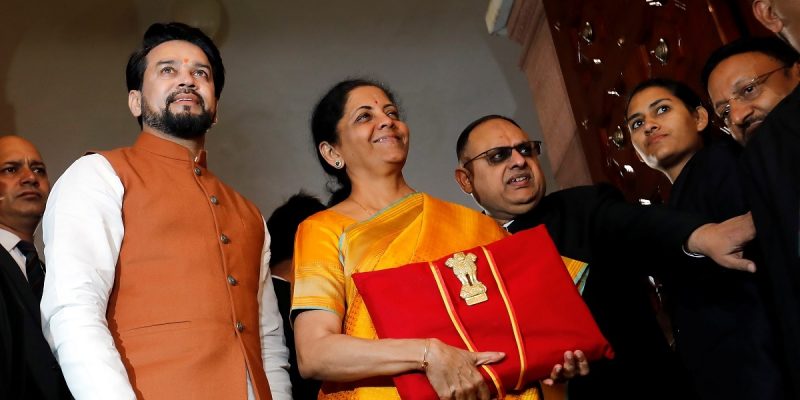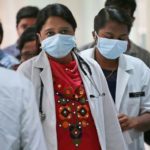Finance minister Nirmala Sitharaman started her Union Budget speech with the following Kashmiri poem written by Dina Nath Kaul. The Hindi translation of the poem reads somewhat like this:
“Humara watan khilte hue Shalimar bagh jaise, humara watan Dal lake mein khilte hue kamal jaisa, nau jawanon ke garam khoon jaisa, mera watan tera watan, humara watan, duniya ka sabse pyara watan.”
– Dina Nath Kaul’s My Wotan (My Motherland)
From the real sense of India’s political economy today, it is difficult to understand what becoming like “Shalimar Bagh” and “Dal Lake’s lotus flower” in troubled times means for the finance minister’s projected aspiration for the nation.
Still, it’s easy to see what the government wanted to do, even despite its fiscal constraints. For the salaried class, an optional personal income tax relief for certain income groups, can be seen as a step to have more disposable income that can aid purchasing power for lower & middle income groups (while making tax-paying easier and simpler).
Let’s look at some of the finer details here.
In a long-budget speech, the longest I can recall, Sitharaman almost provided a central plan manifesto of government intentions under three broader governance objectives: Aspirational India, ‘Economic Development for All’ and achieving ‘A Caring Society’.
For the purpose of a brief reflection on what was announced, it is important to understand what has happened three critical areas of agriculture, (higher) education and some of the direct tax relief measures that the finance minister emphasised on.
On agriculture
The government’s commitment to doubling farmer incomes by 2022 seems to be a pipe dream for now. In steps announced as part of a sixteen-point agenda to boost the agricultural sector, irrigation, water, wellness, sanitation for rural development, the government sought to encourage states to undertake three model agricultural laws on land leasing, contract farming and livestock.
The announcement to encourage a balanced use of all fertilisers and avoid excessive use of chemicals in crop cultivation is welcome but nothing more was said on what incentives farmers will be provided for not using chemical fertilisers; especially given how their use is primarily because of low cost-benefit reasons.
Also Read: With No Big Bang Steps, Budget 2020 Focuses on Untangling the Fiscal Math Mess
Development of warehouses with support offered in the form of gap funding and the use of NABARD’s geo-tagging technology to identify new warehouses is, in theory again welcome, but woefully short on details and intent for the need to scale-up for infra-funds for better cold storage and buffer stock storage facilities.
Further, a step to allow women self-help groups to avail of Mudra/NABARD loans for seed storage (or Dhanya Lakshmi) seems more important from the view of optics rather than something that is likely to cause significant change in rural development plans. A more positive step would have been to enable a conscious expansion of PM KISAN and include more direct-cash transfer benefits for women in rural areas (working as farmers, Asha workers and in angandwadis). Further, nothing was said on the need to substitute agri-subsidies with cash transfers which one would have expected to happen in encouraging rural consumption.
One critical announcement with respect to Farmer Producers Organisations (FPOs) and their extension to coastal regions can allow more farmers to accrue (or benefit) better incomes from better prices, given how FPOs have done well in giving more agency to farmers. However, the scale of returns on this has been limited to only a few geographical spaces in southern states like Tamil Nadu, Karnataka. A more national level focus on FPO development could have helped farmers having more agency and control with access to markets sans intermediaries.

The announcement to encourage a balanced use of all fertilisers and avoid excessive use of chemicals in crop cultivation is welcome. Credit: Reuters/Danish Ismail
On higher education
Even though the finance minister recognised the importance of higher education in improving India’s human capital landscape and for improving employability of young citizens, it is ironical how the New Education Policy remains yet to be announced. After all, this was was supposed to be done in Modi’s first term itself. Still, as compared to last year, the financial outlay for higher education was increased by almost 4.6% i.e. Rs 99,300 crore in FY’21 from Rs 93,847 crore allocated in FY’20.
A focus to externalise India’s higher education sector to attract more foreign students to study in India is welcome and so is the idea to tie in medical colleges with district level medical hospitals in states. The finance minister did mention about the creation of IND-SAT exam for Asian and African students to choose India as a higher education destination. However, an overt reliance on financing through external commercial borrowings and foreign direct investment to meet the growing financial needs of the higher education sector says a lot about the lack of priority attached by the current government to public funding of quality education in India. If the idea is to develop education holistically and comprehensively then public funding and government support needs universal funding and more targeted allocations for improving the “research” and “teaching” orientation of educational institutions.
Also Read: In a Surprise Move, Education Ministry’s Budget Hiked by 5%
A higher outlay may mean very little unless one has more clarity on where (and how) it will be spent and when there are other integral issues of academic freedom, creative autonomy and lack of support for research in most of the public institutions across the country. This also ties in with a related issue of poor employability of educated youth in India (especially worse for females in urban and rural areas) as voiced earlier. Even if many foreign students choose to come to India for higher studies, with very little prospects of getting a job (as seen right now), it isn’t clear on what the government’s plan is. Linking employment with higher education and improving its existing quality had to be this government’s number one objective, and this Budget, like the one in previous years, offers very little clarity in this regard.
On direct tax measures
One of the big announcements drawn from the Union Budget speech of the finance minister was the optional personal income tax relief plan presented to change the existing tax slab for salaried classes to the following:
| Annual Income Slab (Rs.) | New (Optional) Tax Rate | Previous (Old) Tax Rate |
| 0-2.5 lacs | No Tax | No Tax |
| 2.5-5 lacs | 5% | No Tax |
| 5-7.5 lacs | 10% | 20% |
| 7.5-10 lacs | 15% | 20% |
| 10-12.5 lacs | 20% | 30% |
| 12.5-15 lacs | 25% | 30% |
| 15 lacs and above | 30% | 30% |
The finance minister also announced that the government has removed around 70 exemptions in the new simplified income tax regime for citizens to file their tax returns without the help of (tax) advisers. Additionally, the dividend distribution tax (DDT) has now been abolished as well.
It is important to acknowledge that the new personal income tax regime, combined with the removal of DDT could, for some, lead to a higher burden of tax for some investors, considering that the dividends will be taxed in the hands of the shareholders at regular tax rate and in case of high net worth individuals at a marginal rate of 43% or so. For many, the expectation was that the shareholders would be taxed at concessional rates. And with no exemptions, this step might also discourage small savings which are in the form of fixed deposits, insurance, housing interest etc.
In any case, judging from the merit of announcements made, and looking at the ailing condition of the Indian economy, Budget 2020 comes across as one that targets rural and social sector spending. The question is whether this is enough and to what extent would these financial outlays help in driving short-term demand, increasing both rural and urban consumption and thereby private investment, which is the most critical need in generating jobs.
There were no clear, direct set of measures to hand in cash or direct income transfers to different groups for increasing consumer spending, nor any concrete steps taken for the corporate industry to kick-start investments in building new capacities. This explains, to a certain extent, the negative sentiment seen in the stock markets. There remains a big question mark on whether Nirmala Sitharaman’s effort to revive consumer and producer sentiments through in-direct steps and reliance on big-infra projects and mega-deals – as seen with the earlier announcements on National Infrastructure Pipeline and Affordable Housing plan – will actually yield any short-term positive returns.
Deepanshu Mohan is assistant professor of economics at Jindal School of International Affairs, O.P. Global Jindal University.




